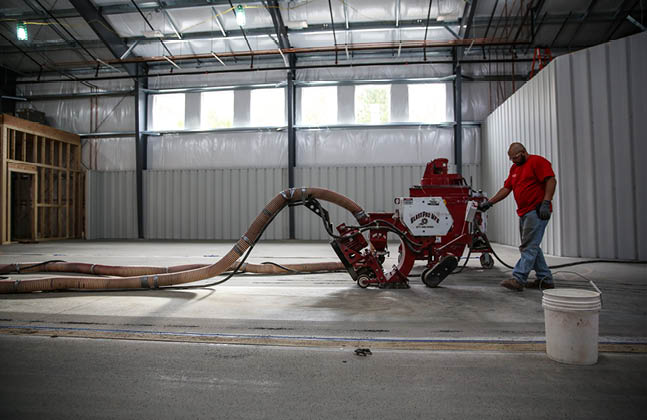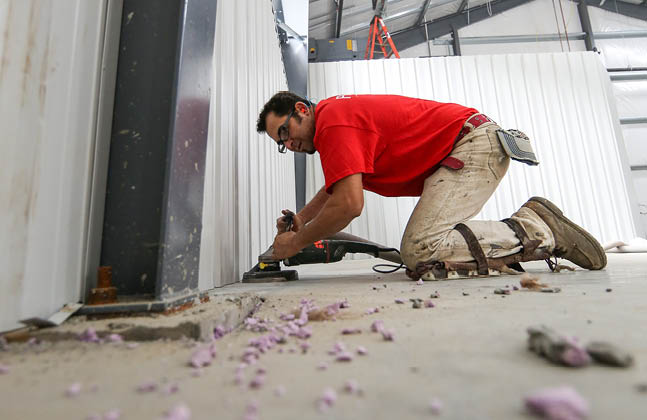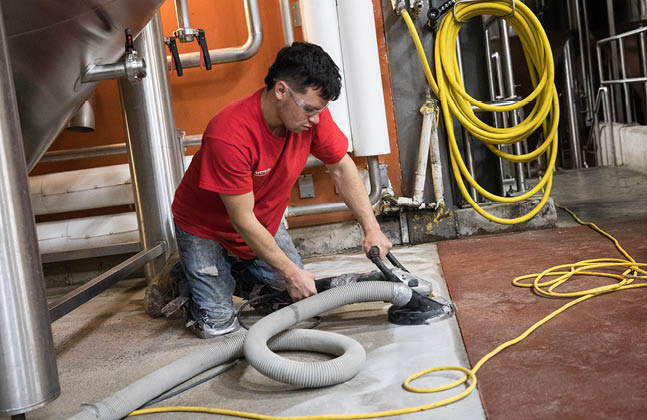If you have read the blog post titled ‘Surface Preparation and its Importance – Part 1’ and want more information on how to properly prepare surfaces ahead of coating applications, then you have come to the right place.
As Part 1 outlines, most floor failures are a result of improperly prepared surfaces. Using one or a combination of the following surface preparation methods and equipment will ensure that your floor surface is prepared properly and thoroughly, leaving you with the ideal foundation for a durable coated surface.
Captive Shot Blasting:
Shot blasting is a surface preparation method that blasts the concrete surface with small steel balls at a high velocity. It is mainly used to remove any contamination and provide a textured surface in preparation for the application of sealers, coatings or polymer overlays. It is a highly effective method to remove the previously laid polyurethane/epoxy/methyl methacrylate (MMA) coatings thus producing very little airborne dust or contamination.
Diamond Grinding:
This is the most widely used economical alternative to the shot blasting method. This method involves rotation of one or multiple abrading disks or stone fitted with diamond cutting grain, and can produce a profile anywhere from 60 grit sandpaper finish to a highly polished concrete floor. Diamond corrects irregularities such as minor pits and divots, faults and roughness on concrete pavements. This also leaves a very smooth profile, ideal for thin mil coating or sealer applications. Diamond grinding also profiles the concrete and removes contaminants from the surface.

Preparation is key to have an ideal foundation for a durable coated surface
Scarification:
Scarification is faster, but also the most aggressive and expensive method of concrete or concrete coating removal. This technique is recommended to eliminate bumps on an uneven surface or to remove thick layers of epoxy. Scarifiers are used to remove the top layer of the concrete to expose a fresh, clean surface. Dust protection is required when around this method, especially when in the presence of machinery and food products.
Scabblers:
Scabblers use compressed air to hammer piston-mounted bits into the concrete surface, leaving a much more rough surface to the concrete than is achieved by grinding or scarifying. Scabbling is used primarily on horizontal surfaces to remove spalling concrete, loose or deteriorated concrete and brittle coatings such as epoxy, polyurethane or methyl methacrylate systems up to 1/4 in. (6 mm) in preparation for overlays. This method is suitable for use in interior and exterior applications.
Hand Tool Cleaning:
This can be in the form of high pressure water blasting. Water blasting at 3500-4500psi can easily remove loose concrete, mortar, eroded and weak concrete, dirt and chemical contamination. It will not remove laitance, oil, grease or old coatings. Water blasting is dust free but requires good drainage to dispose of the large volume of water.
Scraping:
Scrapers are used to remove a wide range of floor coverings, waterproofing membranes, adhesives and thick coatings.

Every section of the surface needed preparation to high SSPC standards
Substrate Survival:
Moisture and expansion can create problems for substrates; luckily there are ways to prevent these issues. Applying a damp proof membrane can create a water-free, moisture tolerant primer between the substrate and decorative surface layer, which combats several problems related to moisture.
In an area that is prone to differing temperatures, cementitious polyurethane works well, due to its ability to expand and contract with the substrate, rather than displaying different behaviours and increasing the chances of cracks forming.
Finally, using a highly resistant polyurethane coating can be a protective barrier between contaminants and the substrate, avoiding corrosion and damage to the concrete foundations.
Substrate preparation standards from the Society for Protective Coatings (SSPC) and the National Association of Corrosion Engineers International (NACE) for concrete substrates include SSPC-SP13 / NACE 6, which provides requirements for surface preparation of concrete by mechanical, chemical, or thermal methods prior to the application of bonded protective coating or lining systems.

Requirements for surface preparation are outlined by the SSPC and NACE
The basic standards for preparing metal substrates are similarly a joint effort between the SSPC and NACE, and range from SSPC-SP1 Solvent Cleaning at one end, to the more heavy-duty SSPC-SP14 / NACE 8 Industrial Blast Cleaning method at the other. Standards in between include SSPC-SP11 Power Tool Cleaning to Bare Metal, SSPC-SP2 Hand Tool Cleaning and SSPC-SP3 Power Tool Cleaning and SSPC-SP5 / NACE 1 White Metal Blast Cleaning.
These standards detail the techniques and acceptable parameters required to ensure that any metal substrate can be made free from contaminants such as visible oil, grease, dust, dirt, mill scale, rust, coating, oxides, corrosion products and other foreign matter.
If you are unsure of the exact requirements for your flooring substrate, whether metal or concrete, your coatings supplier will always designate the degree of surface preparation required for the materials that you are using.
1 thought on “Surface Preparation – Methods of Preparation Part 2”
Comments are closed.






Great to read your post.